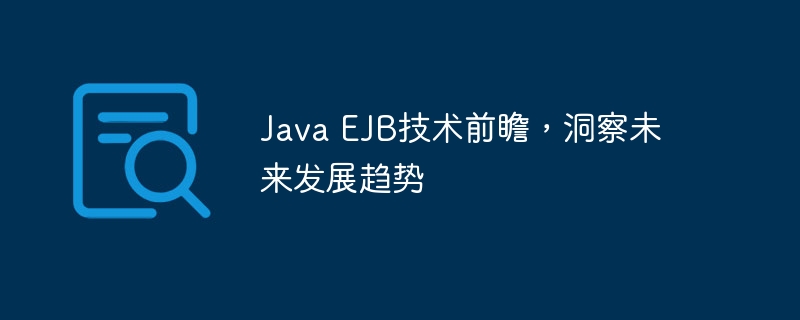Home >Java >javaTutorial >Java EJB technology foresight and insight into future development trends
Java EJB technology foresight and insight into future development trends
- 王林forward
- 2024-02-21 13:04:35557browse

Java EJB technology has always been an important tool for enterprise-level application development. With the continuous evolution of technology, its development prospects have attracted much attention. In this article, PHP editor Yuzai will bring you a forward-looking discussion of Java EJB technology, provide in-depth insights into future development trends, and help you understand the importance and impact of this technology in the field of enterprise applications.
Cloud computingThe popularity of EJB technology has had a significant impact. EJB Server can now be deployed on cloud platforms such as AWS, Azure and Google Cloud, which provides scalability, reliability and cost-effectiveness. In addition, Cloud-native EJB implementations such as OpenEJB are optimized for cloud environments, with features such as automatic scaling, failover, and continuous integration.
Microservice architecture
The rise of microservicesarchitecture has posed new challenges to EJB technology. Traditionally, EJB applications have been monolithic, but microservices architecture requires applications to be broken down into smaller independent services. EJB 3.2 introduced stateless beans, which are useful for deploying EJBs in microservices environments. In addition, new microservices frameworks such as Quarkus provide support for EJBs, allowing developers to easily build and deploy microservices-based EJB applications.
Continuous Delivery
Continuous delivery (CI/CD) practices are becoming the standard for EJB development. CI/CD pipelines Automate the build, test and deployment processes, thereby increasing development speed and application quality. EJB technology integrates well with CI/CD tools and technologies such as jenkins and Docker, enabling developers to implement efficient continuous delivery processes.
Demo code
The following is sample code for building a simple EJB microservice using Quarkus:
import javax.ejb.Stateless;
@Stateless
public class GreetingEJB {
public String greet(String name) {
return "Hello, " + name + "!";
}
}
This EJB class provides a simple greeting method. It uses the @Stateless annotation to indicate that this is a stateless session bean.
Best Practices
To take advantage of future trends in EJB technology, developers can follow the following best practices:
- Embrace cloud-native EJB implementation for scalability and reliability.
- Explore microservices architecture to increase flexibility and reduce coupling.
- Implement CI/CD pipelines to automate and accelerate the development process.
- Take advantage of new features in EJB 3.2, such as stateless beans and JPA 2.2.
- Follow best practices such as using dependency injection and transaction management.
in conclusion
EJB technology is evolving to accommodate the rise of cloud computing, microservices and continuous delivery. By embracing these trends and following best practices, developers can build EJB applications that are robust, flexible, and scalable. As the EJB ecosystem continues to innovate, it is expected that EJB technology will play a vital role in enterprise application development in the future.
The above is the detailed content of Java EJB technology foresight and insight into future development trends. For more information, please follow other related articles on the PHP Chinese website!

